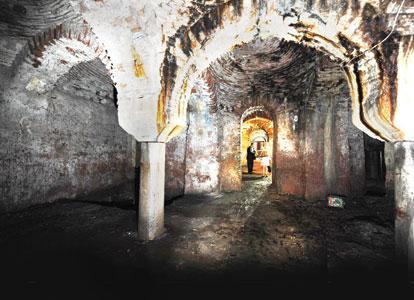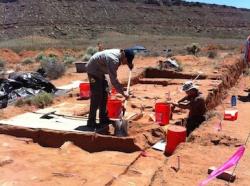- 04 AOÛT
- INDI-UNI : 
PRE-INSCRIPTION : 15 Juin – 15 Août
PRE-REGISTRATION: June 15th - August 15th
- CHINE – Zhengzhou - Archaeologists in central Henan Province have identified an ancient canal site as part of the Grand Canal, the longest artificial waterway in the world. The discovery will be added to the joint application of sites along the Beijing-Hangzhou Grand Canal for World Heritage status. Experts have studied the waterway of the Suoxu River in the city of Zhengzhou, capital of Henan Province, confirming it as part of the Tongji Canal, the western extension of the Grand Canal. Relics of ancient dikes and paths on the riverbank have also provided proof to the experts' theory that the canal was initially built in the Warring States (475 - 221 BC) and later connected to the network of the Grand Canal. The main waterway of the Grand Canal starts in Beijing and passes through several provinces in north and east China to reach the resource-rich Hangzhou. The oldest sections of the 1,776-km canal were built 2,500 years ago, and they were linked together in the Sui Dynasty (581 - 618). Part of the canal is still in use today.
http://www.kaogu.cn/en/detail.asp?ProductID=2986
- FRANCE – Lyon - Le chantier du Grand Stade n’a pas encore commencé, mais le sol est déjà éventré. Prévues depuis près de quatre mois, les fouilles archéologiques du site du Montout, commandées par le service régional d’archéologie, sont lancées. En 2010, l’Inrap avait découvert lors de sondages la présence de vestiges des époques néolithique, romaine et médiévale (vases, silos, etc.) Etendues sur sept hectares, les fouilles vont durer cinq mois.
http://www.revuepresse.info/lyon/grand-stade-les-fouilles-archeologiques-ont-commence/
- FRANCE – Nantes - L’association Forum Nantes Patrimoines s’inquiète de l’impact éventuel des projets de parcs éoliens offshore sur le patrimoine archéologique maritime. Selon son porte-parole, Jacques Santrot, par ailleurs conseiller scientifique au département de Loire-Atlantique, la zone de la péninsule armoricaine regorge en effet de vestiges de toutes époques. « Elle a toujours été le lieu d’importants trafics maritimes, rappelle le scientifique. Nous avons retrouvé des vestiges du néolithique provenant du Portugal ou des actuels Pays-Bas. » Sans compter la bataille de César contre les Vénètes ou les batailles navales des navires de la duchesse Anne…Le gouvernement vient d’ouvrir la voie à la réalisation des cinq premiers parcs éoliens offshore français, dont la construction devrait démarrer en 2015. L’un d’eux prévoit la construction de 150 éoliennes au large de Saint-Nazaire. « L’impact sur le sous-sol maritime sera loin d’être négligeable, assure Jacques Santrot. Outre le socle de ces énormes machines, il faudra construire des sous-stations électriques, tirer des câbles, etc. Or, rien n’est prévu en matière d’archéologie préventive sous-marine. »
http://www.la-croix.com/Actualite/S-informer/France/Les-eoliennes-offshore-une-menace-pour-les-tresors-sous-marins-_EP_-2011-08-04-695755
- FRANCE – Poitiers - On pourrait parler de découvertes classiques tant le sous-sol du centre-ville de Poitiers est riche en occupation humaine. En creusant derrière la mairie de Poitiers, à l'emplacement du futur parc public Les Jardins de Puygarreau, les archéologues ont mis au jour « une occupation antique datant du I au IV siècle », explique Anne Jégouzo, archéologue à l'Inrap. Ces recherches sont réalisées à 4 m environ sous le niveau de la route. Surtout elles se déroulent, sur leur totalité, au coeur de la ville du Haut-Empire et à l'intérieur de l'enceinte historique de la vieille ville de Poitiers (au Bas-Empire les remparts étaient situés au niveau de l'arrière de la mairie). Anne Jégouzo fait le point sur les premières conclusions: « Nous avons découvert des signes d'occupation antique, sur une hauteur d'un mètre, datant du I au IV siècle. Nous avons mis au jour des murs et trouvé des céramiques. Nous sommes en présence d'habitat luxueux même si on ne distingue pas encore le bâtiment ». Ensuite plus rien, ou presque, jusqu'au XVI siècle. Les archéologues vont maintenant poursuivre la descente dans le sous-sol pour remonter le temps avec l'espoir de découvrir, comme rue de la Marne (chantier du théâtre), des traces d'occupation gauloise. Des éventuels traces d'occupation préhistorique seraient en revanche une première pour le centre-ville.
http://www.centre-presse.fr/article-161777-le-sous-sol-derriere-br-la-mairie-a-deja-parle.html
- PANAMA -  Archaeologists from Texas State University believe they have uncovered a ship found near the site where Welsh Admiral Sir Henry Morgan's ships wrecked in 1671. The infamous privateer - widely known as Captain Morgan - was on his way to Panama City with his men.The researchers say they might have found a section of the hull as well as cargo boxes and coral-covered chests. Trystan Young reports.
Archaeologists from Texas State University believe they have uncovered a ship found near the site where Welsh Admiral Sir Henry Morgan's ships wrecked in 1671. The infamous privateer - widely known as Captain Morgan - was on his way to Panama City with his men.The researchers say they might have found a section of the hull as well as cargo boxes and coral-covered chests. Trystan Young reports.
VIDEO = http://www.bbc.co.uk/news/world-latin-america-14391855
- TURQUIE –

Istanbul - Kadir Has University is waiting for municipal consent to start restoration and conservation of the Cibali Cistern under its campus by the Golden Horn. University Rector Mustafa Aydın says the historical structure will serve as another story for the Rezan Has Museum that sits on its upper floor. Dating back to the 11th century, the Cibali Cistern bears an eclectic architectural design because the columns were brought from other structures dating back to later times. The cistern consists of 48 domes and 20 columns. Aydın said the excavation work consists of uncovering the soil that was dumped on the ground in the following century after the structure stopped functioning as a cistern.“There is an Ottoman hamam right above, which we are exhibiting in the Rezan Has Museum. The hamam dates back to the early 17th century, its makers probably wanted to benefit from the water storage area and therefore they built it on top of the cistern,” he said.
http://www.hurriyetdailynews.com/n.php?n=university-to-uncover-cistern-below-campus-2011-08-03
- USA –  Utah - The Utah Department of Transportation (UDOT) is nearing successful completion of archaeological fieldwork on a portion of Southern Utah’s newest road following a rare firsthand view of archaeology-in-action by the public two months ago. Since that time, archeologists have methodically exposed five Virgin Anasazi (Ancestral Puebloan) habitations at one of the sites located within the corridor of state Route 7 known as the Southern Parkway, including one that may have been built as early as two thousand years ago.
Utah - The Utah Department of Transportation (UDOT) is nearing successful completion of archaeological fieldwork on a portion of Southern Utah’s newest road following a rare firsthand view of archaeology-in-action by the public two months ago. Since that time, archeologists have methodically exposed five Virgin Anasazi (Ancestral Puebloan) habitations at one of the sites located within the corridor of state Route 7 known as the Southern Parkway, including one that may have been built as early as two thousand years ago.
http://www.stgeorgeutah.com/news/archive/2011/08/02/udot-archaeologists-transport-the-public-through-the-past-and-the-future/
- RUSSIE – Erbent (Daguestan) - The recent research expedition to Dagestan undertaken by the Archaeological Institute RAS resulted in in impressive discoveries in Derbent area. Near the village Rubas there were found objects from the tombs dated 4-5 centuries B.C. Among them: semi-precious stones, pots and other household items. It was noted that the search operation in the area has been conducting for more than 130 years. During this time 145 burial grounds were excavated. The total number of mounds amounts to two thousand. The excavations were interrupted in 1987 and started only three years ago.
http://www.riadagestan.com/news/2011/08/04/7064/